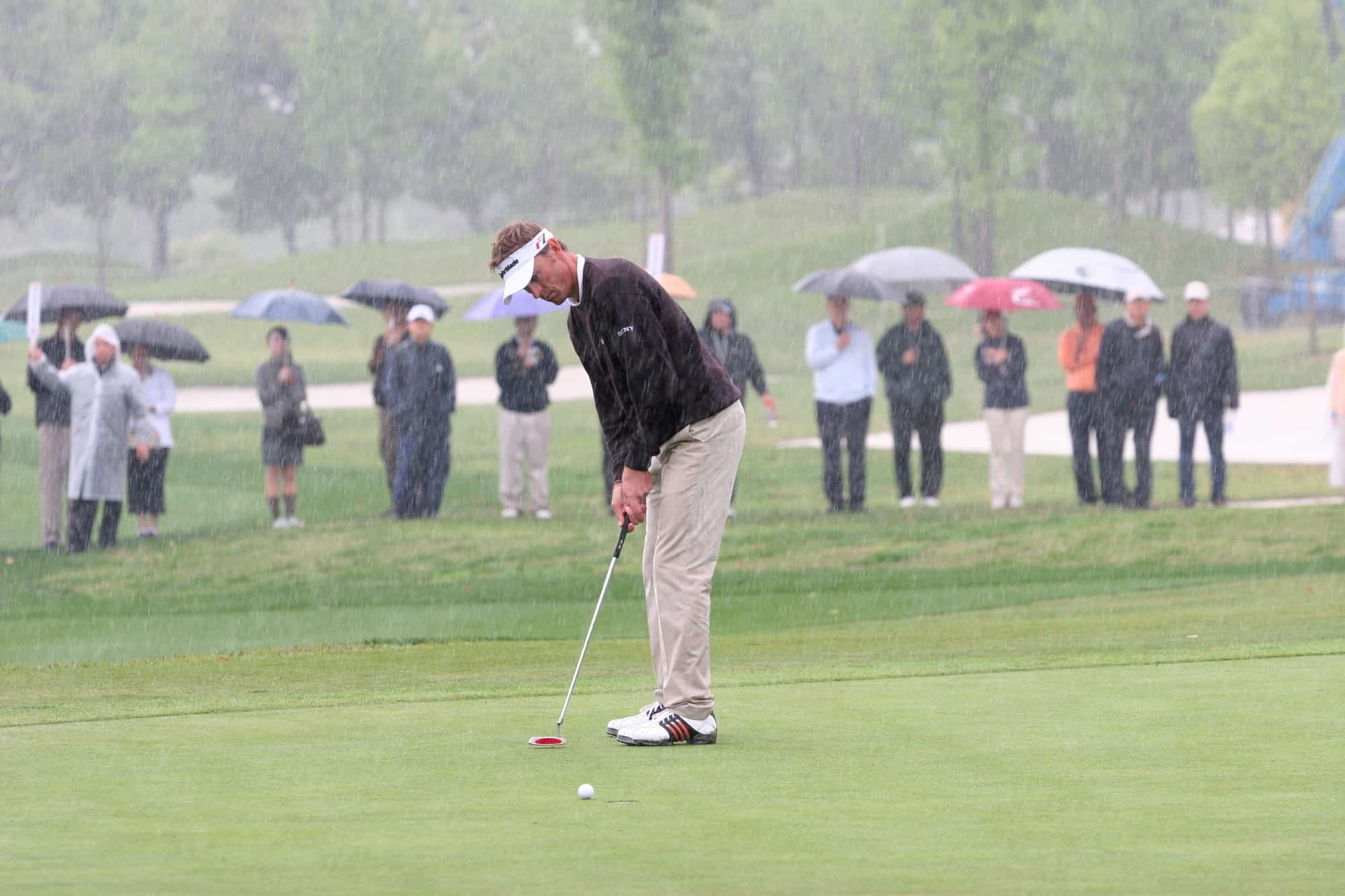Master Your Swing: Where to Hit the Golf Ball With an Iron
The ideal spot to hit the golf ball with an iron is the sweet spot. This is the point where the clubface meets the ball, producing maximum distance, accuracy, and consistent ball flight.
When it comes to hitting an iron shot in golf, the key is to strike the ball with precision and accuracy. To do this, you need to find the sweet spot. This is the exact point on the clubface where the club meets the ball, producing maximum distance, accuracy, and consistent ball flight.
Hitting the sweet spot requires practice, patience, and a good swing technique. In this article, we’ll look at some tips and tricks to help you hit the sweet spot with iron and improve your golf game.

Credit: www.amazon.com
Iron Selection And Set-Up
Golfers understand the significance of club selection when playing the game. Deciding which club to use for each shot will determine the trajectory, distance, and accuracy of the ball’s flight. This is especially true when it comes to hitting the ball with an iron.
In this section, we’ll focus on iron selection and set-up and provide tips to help you perfect your swing.
How To Select The Right Iron For Your Swing
When deciding which iron to use for a given shot, golfers must take into account several factors that will determine the correct club for their swing. These include:
- Player experience level: A beginner golfer is more likely to use a higher iron number (7-9) due to the ease of use, while experienced players might use lower-numbered irons (1-6).
- Distance to the hole: If you’re closer to the hole, you’ll need loft and control. A higher iron number (up to 9) is more appropriate. If you’re farther away, use a lower iron number (3-6) to gain more distance.
- Course conditions: If you’re playing on a course with a lot of hazards, use a higher iron number to gain more control and elevation.
Proper Set-Up And Alignment For An Effective Swing
Once you have selected the right iron, the ball’s position in set-up can determine the trajectory, distance, and accuracy of the shot. Here are the essential elements of proper set-up and alignment:
- Alignment: Proper alignment is crucial because it’s the foundation of a strong and consistent swing. Ensure your shoulders, hips, and feet are square to the target line.
- Ball position: Where you place the ball in the set-up is crucial to where it’ll land. For a straight shot, place it in the middle of your stance; for a draw shot, position it slightly in front of the middle; for a fade shot, have it slightly behind the center of your stance.
- Posture: For an effective swing, it’s essential to have good posture. Keep your back straight, your feet and shoulders parallel to the target line, and relax your arms.
Importance Of Grip And Ball Position
Finally, it’s important to understand the grip and ball position. Here are some points to keep in mind:
- Grip: A proper grip is essential for generating power and accuracy in the swing. Grip the club lightly, with your hands coming together, and buckle up the top knuckle on your index finger for the left-hand (right-hand for left-handers) grip.
- Left wrist position: The left wrist should be flat relative to the back of your hand when gripping the club, meaning your hands are level with each other.
- Swing path: The swing path should be inside out to create a draw, and outside in for a fade.
Knowing how to select the right iron, proper set-up and alignment, and the importance of grip and ball position are essential to perfecting your swing. Remember to apply these tips in your next game, and you’ll see your golfing skills improve.
Understanding The Target
Where to hit the golf ball with an iron: understanding the target
Golf is a game of precision, and understanding where to hit the ball with an iron is crucial to making the right shot. While golfers might be tempted to aim for the flagstick, it’s important to remember that there are many factors to consider when approaching a shot.
In this section, we’ll explore those factors, including how to read the course and terrain, and the importance of knowing your limitations and abilities.
Factors To Consider When Approaching A Shot
Before hitting any shot on the course, it’s important to take into account several key factors. These factors may include:
- Distance to the target
- Wind speed and direction
- The Lie of the Ball
- The slope of the ground
- Any hazards or obstacles in the way
By paying close attention to these factors, golfers can make more informed decisions about how to approach their shots. For example, a shot over water might require a different club or approach angle than a shot on a flat fairway.
How To Read The Course And Terrain
To make the most of your approach shots, it’s essential to understand how to read both the course and the surrounding terrain. Doing so can help you identify potential challenges, as well as areas where you might be able to take advantage.
One important technique for reading the course is to take the time to study each shot before you make it. This might include walking around the green to examine the slope and contour or studying a fairway to identify areas where the ball might roll off into a rough.
Importance Of Knowing Your Limitations And Abilities
Finally, it’s essential to consider your limitations and abilities when taking approach shots on the golf course. Every golfer has their unique strengths and challenges, and understanding these can help you make more informed decisions on the course.
Some factors to consider here might include understanding your skill level, your level of physical fitness, and any health concerns that might impact your performance. By taking all of these factors into account, you’ll be better equipped to make the right decisions on the course and hit the ball with precision and confidence.
Hitting The Sweet Spot
Golf is a challenging sport that requires both skill and patience. As a beginner, it can be not very clear to try and figure out the right technique for hitting the ball with an iron. One essential element to consider is hitting the sweet spot on the clubface.
In this section, we’ll explore the sweet spot and how consistently hitting it can improve your distance and accuracy.
Explanation Of The Sweet Spot On The Clubface
The sweet spot is the area on the clubface where the transfer of energy from the clubhead to the ball is most efficient. It’s the ideal point of contact to generate maximum ball speed, distance, and accuracy. The sweet spot varies depending on the club, but in general, it’s located in the center of the clubface.
When the ball is struck on the sweet spot, there is minimal twisting or turning of the clubface, ensuring a straighter ball flight.
How To Consistently Hit The Sweet Spot
Hitting the sweet spot consistently takes practice. It requires a combination of good swing mechanics and a proper setup. Here are some tips to help you get it right:
- Ensure proper club fitting to have a club with the right length, lie angle, and shaft flex.
- Focus on your swing tempo, and try to maintain a consistent rhythm throughout the swing.
- Keep your head still and your eyes on the ball.
- Position the ball in front of the center of your stance, and make sure your weight is balanced.
Importance Of Finding The Sweet Spot For Distance And Accuracy
Hitting the sweet spot is crucial for distance and accuracy. When you hit the sweet spot, the ball travels farther and straighter than off-center hits. Striking the ball closer to the toe or heel of the clubface results in a loss of ball speed and accuracy.
The sweet spot allows the clubface to compress the ball, creating a trampoline effect that launches the ball into the air with a higher velocity.
Hitting the sweet spot consistently requires practice and attention to detail, but it can pay off in improving your distance and accuracy. An essential aspect of the game is finding the sweet spot on the clubface and making it your go-to spot for every shot.
Remember to keep these tips in mind, and you’ll be well on your way to mastering the iron game in no time.
Swing Techniques For Different Irons
Golfers of all levels can benefit from understanding the specific swing techniques required for each type of iron. Knowing how to adjust your clubface and angle of attack based on your iron can make all the difference in the world in terms of the ball striking.
Specific Techniques For Short Irons
Short irons, including wedges, are vital for hitting high, soft shots and precision shots around the green. Here are a few techniques to master:
- Keep your stance narrow, with your feet no wider than hip-width apart.
- Position the ball in the center of your stance.
- Swing back with your arms while maintaining a steady head position.
- Generate a lot of clubhead speed through impact.
- Follow-through, focusing on the clubface staying square to your target.
Specific Techniques For Mid-Irons
Mastering the swing of mid-irons, typically 5-, 6-, and 7-irons, requires a combination of power and accuracy. Here are some techniques to focus on:
- Use the center of your chest and sternum to guide your swing.
- Play the ball further forward in your stance.
- Make sure to shift your weight onto your front foot during your downswing.
- Swing back low and slow.
- Follow through, keeping your torso rotated towards your target.
Specific Techniques For Long Irons
Long irons, such as 3- and 4-irons, are excellent for distance and precision shots. But they can be challenging to hit consistently well. Here are some techniques to make your long iron game more manageable:
- Position the ball towards your front foot.
- Keep your hands close to your body during your backswing.
- Finish high with your club and look for a balanced follow-through.
- Hit down on the ball and make sure your divot is forward of where the ball was.
- Keep your elbow slightly bent at impact.
Understanding The Differences In Swing And Ball Flight
It’s easy to make mistakes by failing to adjust to the situation or failing to account for differences in ball flight. Here are some tips to avoid those errors:
- Hitting down on the ball will create a more controlled, lower-trajectory shot.
- Hitting up on the ball will create a higher, longer, and softer shot.
- A squared clubface will help create a straight shot every time.
- Asses the wind and adjust your shots with the appropriate club.
- Make sure to spend some time and get a feel for the shot before you swing.
Importance Of Adjusting For The Situation And Avoiding Common Mistakes
Finally, it’s essential to adapt your shots to fit your current situation. Here are some techniques to perfect your game:
- Consider the lie, wind, and slope before selecting your club.
- Use your natural swing and adjust it to the situation.
- Don’t let yourself get distracted and stick to your game plan.
- Keep your hands and wrists relaxed to maintain club-head speed.
- Practice often to refine your swing.
Those are just a few techniques that can help golfers make better iron shots. It’s not necessary to know hundreds of tips to become an excellent golfer, but it is essential to focus on a few key techniques and practice until they become second nature.
With time and patience, you can master your swing and hit your irons more consistently than ever!
Frequently Asked Questions On Where To Hit The Golf Ball With An Iron
What Is The Best Iron To Hit The Golf Ball With?
The best iron to hit the golf ball depends on the distance and terrain. Generally, a 7 or 8 iron is recommended for short distances, and a 3 or 4 iron for long distances.
Where Should I Aim To Hit The Golf Ball With An Iron?
The sweet spot in the center of the clubface is the ideal aim to hit the golf ball with an iron. It results in a straighter and longer shot.
How Can I Improve My Iron Shot Accuracy?
Practicing proper form, grip, and alignment can improve iron shot accuracy. Visualization and mental preparation as well as using the correct club for each shot can also enhance accuracy.
Conclusion
To sum up, knowing where to hit the golf ball with an iron is crucial to becoming a successful golfer. The right approach shot can make the difference between a par and a bogey, or even a birdie and an eagle.
By focusing on the correct ball placement for the intended target and carefully selecting the right club, you can improve your accuracy and distance on the course. Remember to practice regularly and monitor your progress to refine your skills consistently.
By following these tips and putting in the effort, you can master the art of hitting the golf ball with an iron and elevate your game to the next level. With dedication and perseverance, anyone can become a skilled golfer capable of impressing on the course.
So take these tips to heart and get ready to see improvement in your game.



